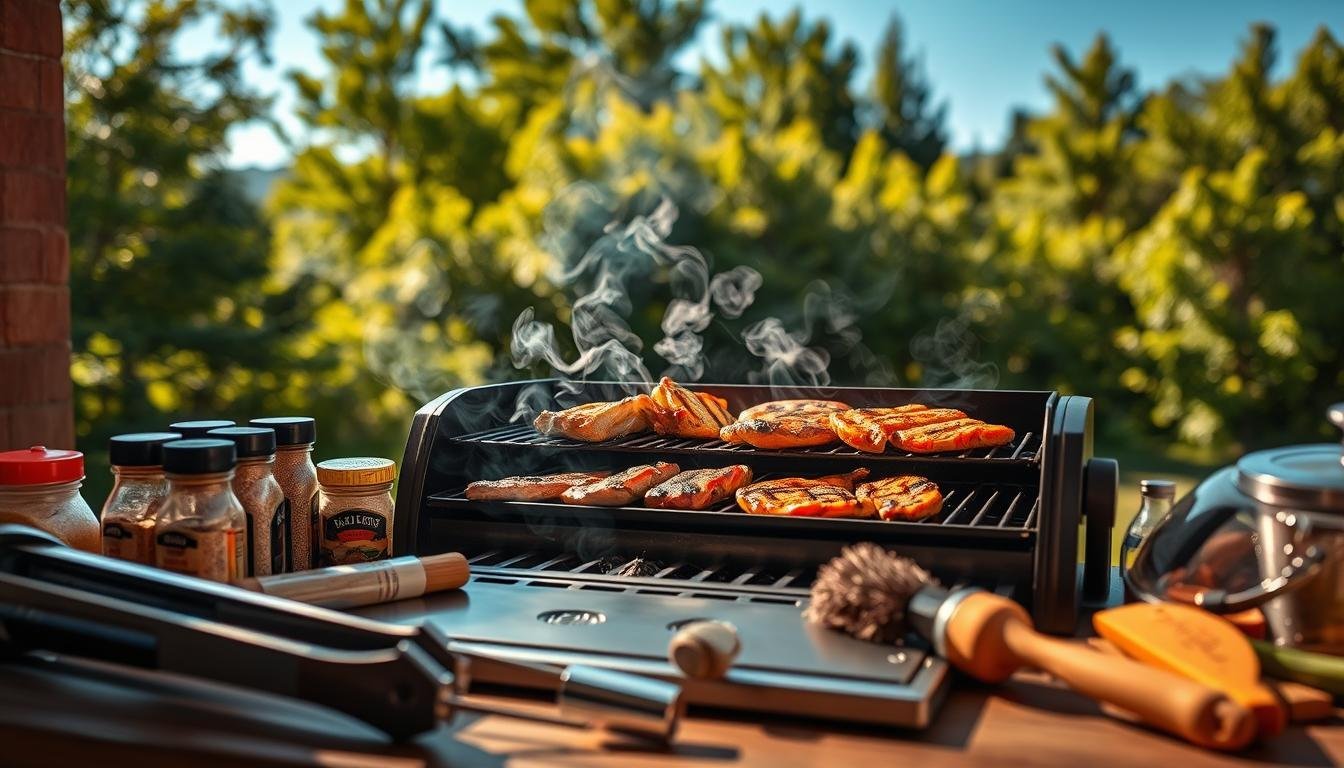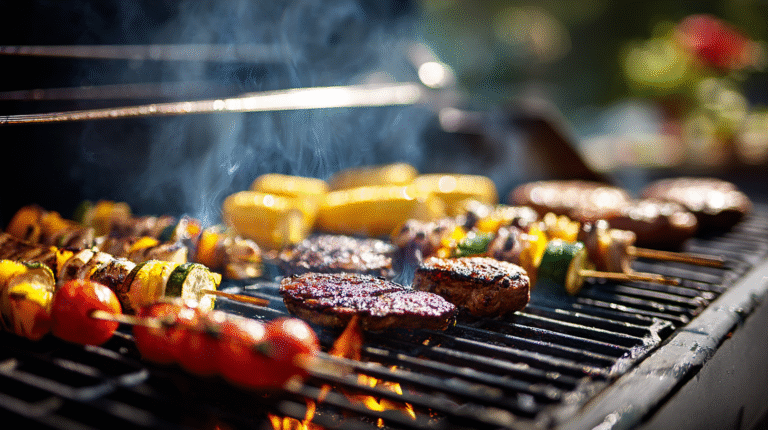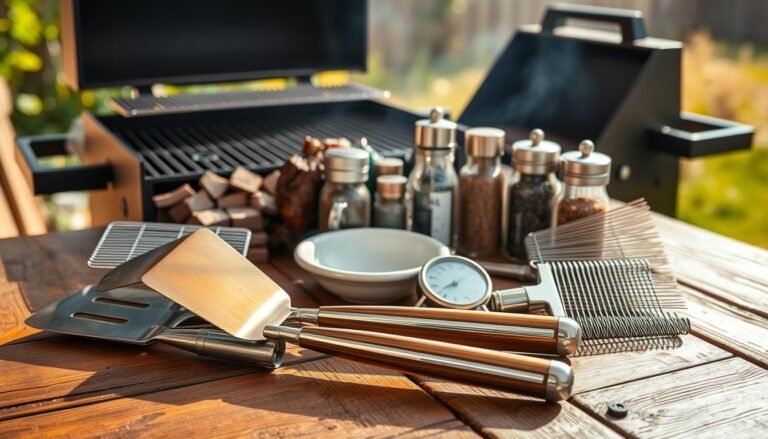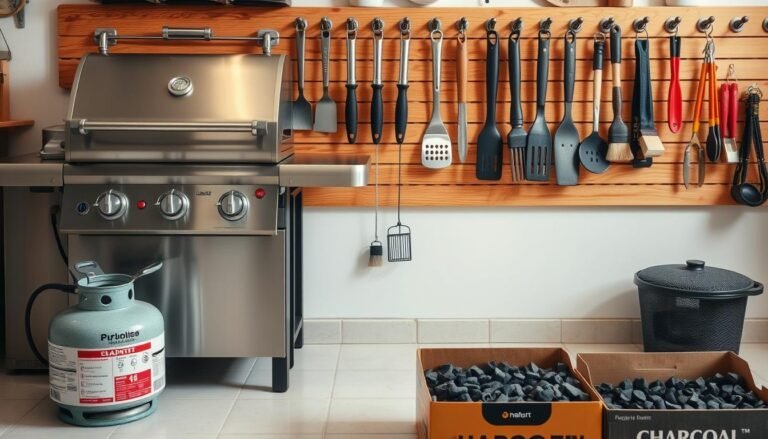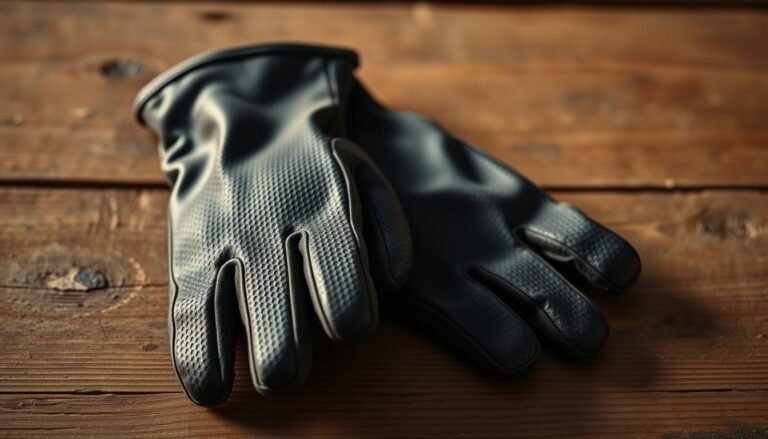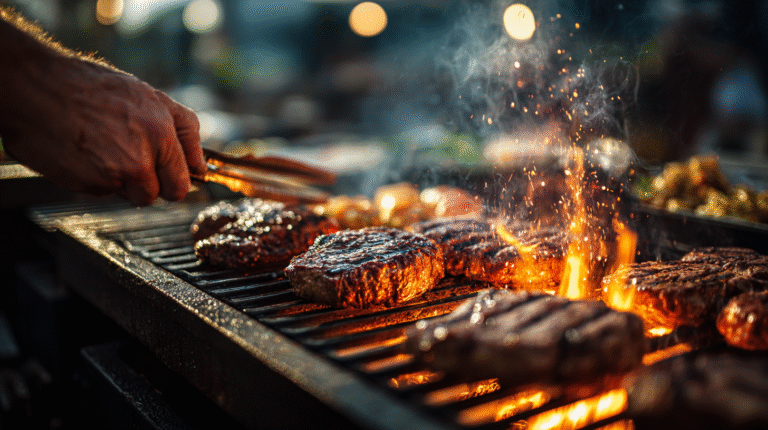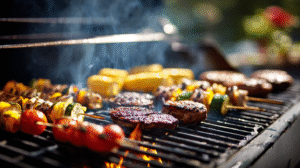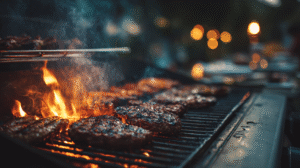Disclosure: This Post Contains Affiliate Links; We earn a commission on purchases.
Grilling is more than just throwing food on a hot grill. To make your barbecue better, learn about smokiness. Smoky flavors make your food taste deeper and more complex.
Grill masters know how to get smoky flavors right. They use the right techniques, wait patiently, and pick the best ingredients. By using grilling tips and knowing about smoky flavors, you can make your grilled dishes even better.
Key Takeaways
- Understand the importance of smokiness in grilled dishes.
- Learn techniques for achieving smoky flavors.
- Discover the science behind smoky flavors.
- Explore ingredients that enhance smokiness.
- Apply expert grilling tips to elevate your barbecue.
The Science Behind Smoky Flavors in Grilling
Grilled dishes are loved for their smoky taste. This comes from complex chemical reactions. Heat and smoke work together to change the food’s flavor.
How Smoke Enhances Food Flavor
Smoke from grilling adds depth to food. It contains compounds like phenols that give off a smoky smell. Learning smoking techniques for flavor can make your grilled food taste better.
The Maillard Reaction and Caramelization
The Maillard reaction happens when food is cooked. It creates new flavors. Caramelization, or sugar browning, adds a sweet taste. Both are key to grilled food’s unique flavors, making your outdoor cooking tricks more effective.
Choosing the Right Wood for Smoking
To get the perfect smoky taste, picking the right wood is key. The wood you choose can change how your grilled food tastes. Woods can give flavors from sweet and fruity to strong and bold.
Hardwoods vs. Softwoods
For smoking, hardwoods are better than softwoods. Hardwoods like oak and maple burn slow and give a clean smoke. Softwoods, like pine, can make food taste bitter.
Popular Wood Types and Their Flavor Profiles
Many woods are used for smoking, each with its own taste. The wood you pick depends on what you like and what you’re smoking.
Fruit Woods for Mild Smokiness
Fruit woods, like apple and cherry, are great for a light smokiness. They add a sweet taste to foods like chicken and pork.
Nut Woods for Medium Intensity
Nut woods, like pecan, give a medium smoky flavor. They work well with many meats, including beef and lamb.
Strong Woods for Bold Flavors
For a strong smokiness, mesquite is best. It’s used for red meats and adds a deep flavor.
Wood Preparation Techniques
Getting your wood ready is important for the right smoke flavor. Soak the wood in water before smoking to avoid flare-ups. 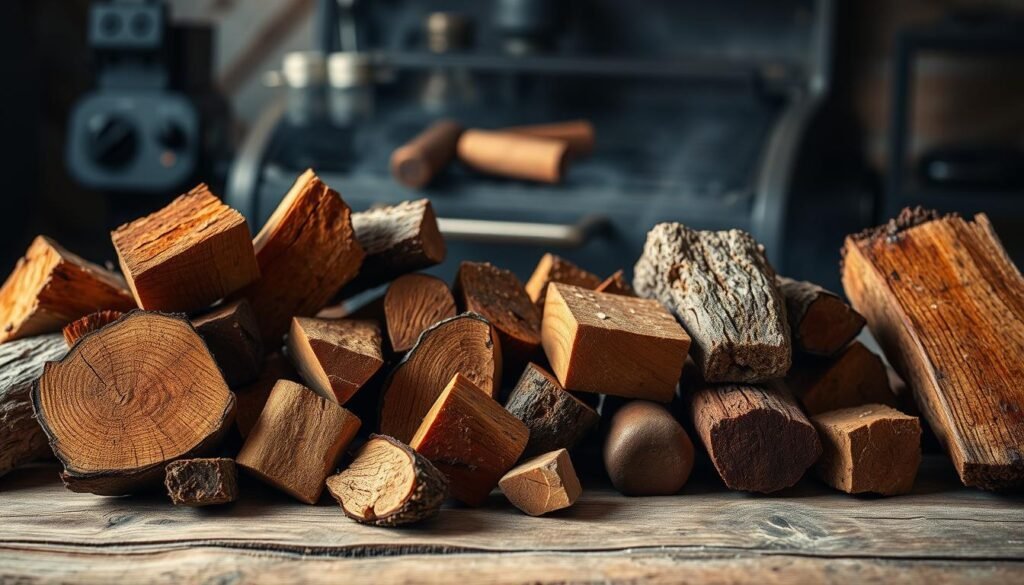
Seasoning the wood also helps. Letting it dry makes it burn better and gives cleaner smoke.
Essential Tips for Adding Flavor and Smokiness to Grilled Dishes
To get the perfect flavor and smokiness in grilled dishes, you need to know a few tricks. It’s all about the right techniques and understanding how to grill. To enhance grilled recipes, think about a few key things that make the flavor great.
Controlling Temperature for Optimal Smoke
Keeping the temperature right is key for smoky flavor. A steady temperature lets the smoke spread evenly, making the food taste better. For the best results, grill at 225°F to 250°F. This is perfect for slow cooking.
Direct vs. Indirect Grilling Methods
Choosing between direct and indirect grilling changes how smoky your food gets. Indirect grilling means food is away from the heat, giving a gentle smoke taste. It’s great for big pieces of meat, keeping them tender and flavorful. For a stronger smokiness, mix both direct and indirect grilling.
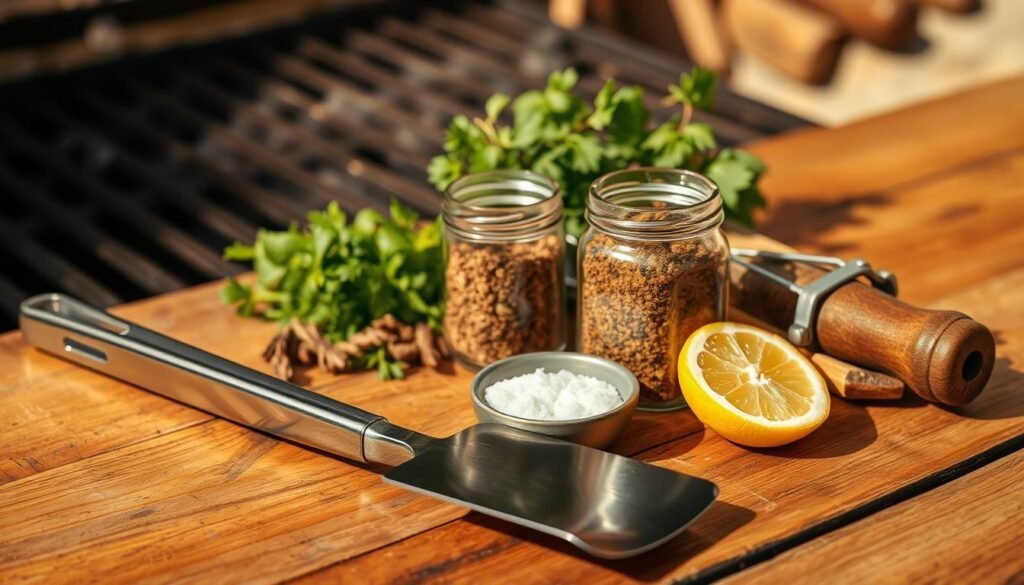
Smoke Duration and Intensity
How long and how strong the smoke is affects the taste of your grilled food. A short smoke gives a light flavor, while a long one makes it stronger. Also, the wood you use changes the taste. For more grilled flavor hacks, try different woods with different meats.
Mastering these tips can really enhance your grilled recipes. You’ll get a perfect mix of flavor and smokiness, taking your grilling to the next level.
Marinades, Rubs, and Brines
Marinades, rubs, and brines are key to bold flavors in grilled dishes. They add flavor and improve texture and moisture.
Creating Flavor-Packed Marinades
Marinades add flavor to grilled meats. Acid-based marinades use vinegar or citrus to tenderize. Oil-based marinades add richness and moisture.
Acid-Based Marinades
Acid-based marinades are great for tenderizing meat. They use lemon juice or vinegar.
Oil-Based Marinades
Oil-based marinades keep meat moist and flavorful. They mix herbs and spices with olive or avocado oil.
Marinating Times for Different Foods
Marinating time changes with the food. Delicate fish needs 30 minutes. Tougher meats need hours or overnight.
Dry Rubs That Complement Smokiness
Dry rubs add flavor to grilled meats. They mix spices, herbs, and sometimes sugar. This enhances smokiness.
- Paprika and garlic for smoky depth
- Cumin and chili powder for spice
- Brown sugar and mustard for sweetness and tang
Brining Techniques for Juicier Results
Brining soaks meat in saltwater to add moisture and flavor. It works well for poultry and pork.
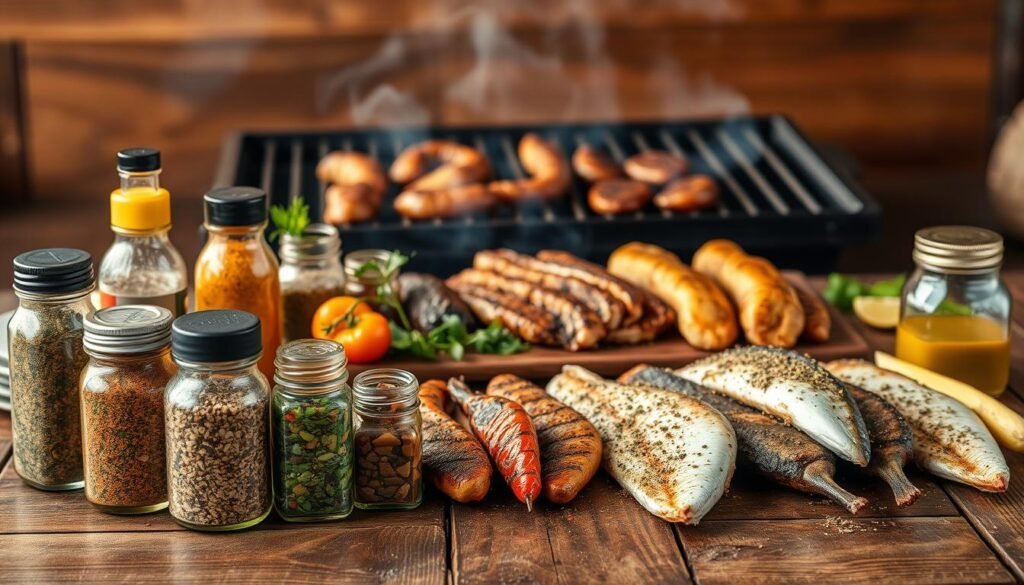
Using marinades, rubs, and brines boosts flavor and texture in grilling. Try different mixes to create your own style.
Smoking Equipment and Accessories
To get that perfect smoky taste, you need the right gear. The smoker or grill you pick can really change how your barbecue tastes and looks.
Types of Smokers and Grills
There are many smokers and grills out there, each with its own perks. Knowing what they offer is key to picking the best one for you.
Charcoal Smokers
Charcoal smokers are loved by many. They give a deep, smoky flavor and can get very hot for searing.
Electric and Gas Smokers
Electric and gas smokers are easy to use. They’re perfect for those who want smoky tastes without the trouble of charcoal or wood.
Pellet Grills
Pellet grills burn wood pellets for fuel. They’re great for a flexible and efficient smoke experience. They also keep the temperature steady.
Essential Tools for Smoke Control
It’s important to control the smoke for the right flavor. You’ll need tools like smoke generators, dampers, and temperature controls. These help manage the smoke and heat, making your dish perfectly smoked.
DIY Smoking Solutions
If you’re on a tight budget or up for a challenge, DIY smoking is a good choice. You can turn a charcoal grill into a smoker or build one from scratch. With some creativity, you can make your smoking setup as good as a pro’s.
Advanced Techniques for Smoke-Infused Dishes
Want to get better at smoke-infused grilling? Learning advanced techniques can really help. You’ll learn how to control smoking to make your grilled food even better.
Cold Smoking vs. Hot Smoking
Cold smoking and hot smoking are two ways to smoke food. Cold smoking is done at low temperatures (below 100°F). It’s great for foods like salmon or cheese, adding a light smoky taste without cooking them too much.
Hot smoking cooks food while adding smoke flavor. It’s done at 225°F to 250°F. Knowing when to use each method is key to getting the right taste and texture.
Smoke-Infused Sides and Accompaniments
Smoking isn’t just for meats. Vegetables, sides, and even desserts can get a smoky twist. Try smoking veggies like bell peppers or eggplants for a tasty side dish.
You can also smoke grains like rice or quinoa. For a sweet treat, smoke fruits like apples or peaches. It’s a mix of sweet and savory.
Troubleshooting Common Smoking Problems
Even pros face smoking issues. Here are some common problems and how to solve them:
Dealing with Too Much Smoke
Too much smoke? Check how much wood you’re using and adjust your vents. Too much wood can overwhelm your dish.
Fixing Uneven Smoking
Uneven smoking? Make sure your food is spread out evenly in the smoker. Also, pick the right wood for your meat.
Preventing Bitter Flavors
Bitter flavors come from bad wood or flare-ups. Keep an eye on your temperature and wood quality to avoid this.
Conclusion
Getting perfect smoky flavors takes practice and trying new things. Learning about smoky flavors and how to smoke seasonings and salt can make your BBQ better. It’s all about trying different woods, temperatures, and smoking times to get it just right.
Outdoor cooking tricks, like controlling temperature and picking the right wood, really help. For more tips on using smoked seasonings and salt, check out Butcher BBQ’s guide.
Using these techniques in your BBQ can make amazing dishes. These dishes will wow your friends and family. So, start smoking and making your grilled recipes better today!
FAQ
What is the best type of wood to use for smoking?
How do I prepare wood for smoking?
What is the difference between cold smoking and hot smoking?
How can I achieve the perfect balance of flavors when grilling?
What are some common smoking problems and how can I troubleshoot them?
Can I use a gas grill for smoking?
How do I add smokiness to sides and accompaniments?

From quick grilling techniques to simple gear advice, Ryan helps beginners and busy home cooks fire up great meals without over-complicating it. Whether you’re using charcoal, gas, or a portable grill, Ryan’s goal is to make grilling approachable, fun, and full of flavor.
Subscribe to Our Newsletter

